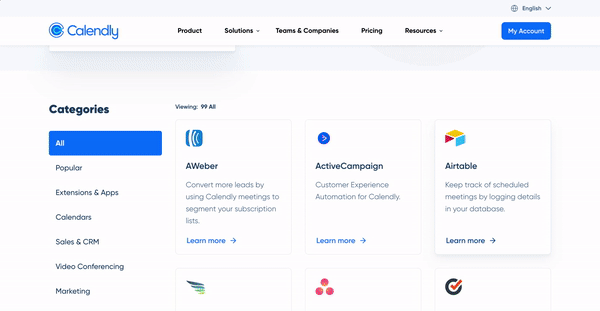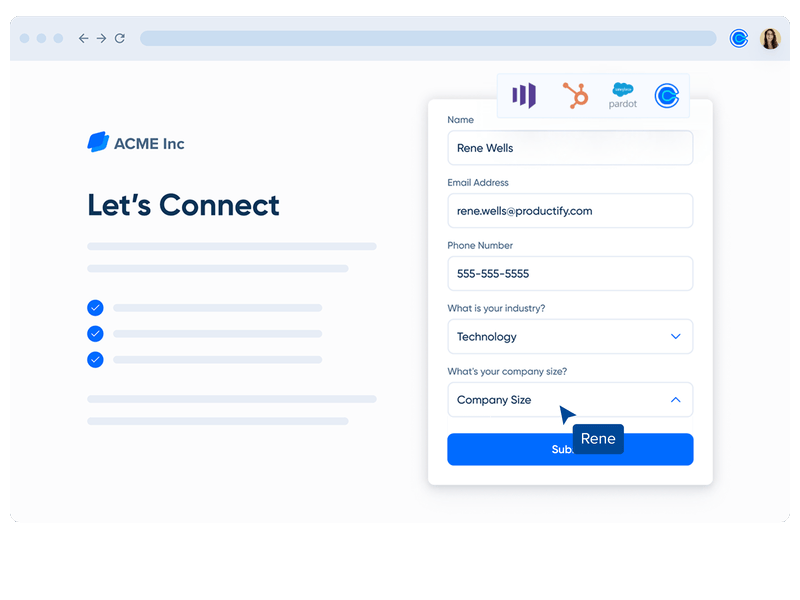Calendly vs Clockwise: Know the key differences
Compare Calendly and Clockwise features, integrations, pricing, and more.
Table of contents
In the world of scheduling software, buyers have begun comparison shopping Clockwise against Calendly. Although both tools aim to streamline and improve meeting scheduling, they cater to much different needs and audiences.
This article explores the main differences between Calendly and Clockwise, helping you choose the right online scheduling software for your needs.
The biggest difference between Calendly and Clockwise? Calendly’s designed to unsnarl complex scheduling scenarios for a variety of team types and industries. In contrast, Clockwise is a time management tool, built for re-arranging internal schedules and creating more uninterrupted focus time for employees.
What is Calendly?
Calendly is the most established scheduling platform on the market. Users connect all their calendars and share their booking pages, and invitees can instantly choose from available times. You control when you’re available, and which meetings you accept. Real-time availability from all of your calendars means you never have to worry about accidental double bookings.
Calendly lets you mix and match if, say, you use an Outlook account at work, and a Google calendar for your family. (Your scheduling link isn’t helpful if people can avoid your work conflicts, but double book you during your child’s soccer game.)
Plus, Calendly is known for its easy user experience. G2 ranks Calendly as one of the easiest-to-use appointment scheduling software platforms.
Who is Calendly for?
Calendly’s easy enough for individual users, and powerful enough to meet the needs of enterprise organizations — including four out of five Fortune 500 companies.
For professional teams of all sizes, Calendly offers much more than just an appointment scheduling link. Calendly’s the only provider that’s created specific solutions for departments across your organization, including sales, marketing, recruiting, customer success, and more.
Team scheduling features make it easy to schedule meetings with any combination of attendees — whether you’re booking client consultations, sales calls with inbound prospects, internal team brainstorms, product demos, vendor and partner meetings, or all of the above. Calendly lets you automate the time-consuming activities before and after meetings, so you can spend less time on admin and more time connecting and collaborating with teammates, customers, and candidates.
Teams of all sizes use Calendly to bring together …
Sales, marketing, and customer success collaborating on a deal
Recruiting, HR, and hiring managers interviewing candidates to fill roles
Customer success, IT, and engineering teams resolving customer issues
… just to name a few! (Check out more specific Calendly use cases here.)
What is Clockwise?
Clockwise is more of a time management tool, designed to improve internal individual and team schedules. Clockwise only supports work accounts. You can sign up as an individual using your work email, but you can’t sign up using your personal email.
Like Calendly, Clockwise also lets you mix and match more than one calendar and syncs with Google Calendar and Office 365.
Clockwise relies on AI to automatically rearrange meetings for you, so you can have more uninterrupted focus time. So it makes sense Clockwise positions itself more like a personal calendar assistant.
Who is Clockwise for?
Since Clockwise is time management software, it’s geared less toward customer-facing teams and more toward engineering, IT, and product teams wanting to streamline internal workflows. Clockwise metrics give less info about meetings with clients and customers, and more on team productivity and focus time.
Clockwise’s main benefit is its emphasis on Focus Time, defined as 2+ hour blocks of uninterrupted work. If a user’s schedule is busy, Clockwise sends proactive alerts that Focus Time is low and suggests how to reschedule some of your team meetings to claim back your time.
Clockwise use cases emphasize Focus Time and another core feature, Flexible Meetings. When you mark a meeting as flexible, you give Clockwise permission to move it when a conflict arises or to maximize Focus Time.
Features shared by Calendly and Clockwise
The platforms share features that enhance scheduling efficiency by allowing users to:
Provide links to schedule meetings, making it easier to find suitable times
Build in buffers between meetings
Create unlimited appointments and meetings
Detect time zones automatically
Sync with Google and Office 365 calendars
Gather information from meeting invitees beforehand with custom questions
Never forget a video conferencing link again
In this golden age of online scheduling, it’s important to note that both Calendly and Clockwise offer direct integrations with most popular video conferencing platforms. Both connect with Zoom, Google Meet, and Microsoft Teams. Calendly also connects to Webex. This means with one click you can include video conference details directly in your event invites, allowing you to scratch another item off your list while keeping all the key information in one place.
Work where you want to
You can use Calendly across devices, since there are browser extensions for Chrome, Firefox, Edge, and Safari, plus mobile apps for iPhone and Android devices. Calendly’s extensions let you share and manage events where you already work, like in your inbox.
Clockwise has Chrome and Firefox extensions and an app for Android devices.
Differences between Calendly and Clockwise
Because Calendly and Clockwise are built for different purposes, their key features are different, as well.
Make it easy for yourself with Integrations
Your new scheduling tool needs to play nice with your go-to apps and devices. Let’s explore integrations for Calendly vs. Clockwise.
Calendly has about 100 integrations, which means you don’t have to worry about any extra setup to make these tools work together.
Take notice of Calendly’s extensive integrations with customer relationship management (CRM) tools, including Salesforce, Hubspot, and Gong, and applicant tracking systems (ATS) like Greenhouse and JazzHR.
Why is that such a huge deal? It’s the ultimate in time savings and convenience. Those connections mean you can automatically sync meeting information with your records for prospects, customers, and candidates. No more manually entering meeting notes into your records, and no more starting meetings without context about who you’re meeting with and why.
“Having a Salesforce lookup feature has been critical. It's been important in reducing the chaos and ensuring a clean client experience.”
Bryce Kropf
Sales Enablement Manager at Smith.ai
Other Calendly integrations include everything from productivity tools like Monday.com to communication tools (Loom, LinkedIn Messaging, Microsoft Teams Chat, etc.) to marketing tools like MailChimp.
Calendly also lets you collect payments via Stripe or PayPal at the time of booking, which freelancers and small businesses love!
Clockwise has a handful of practical integrations with communications and productivity tools to help you schedule and save time, like Asana and Slack (both available in Calendly, too). But there aren’t any integrations with the tools your teams use every day as your one source of truth, like your company’s CRM or ATS.
Find more Focus Time
Since Clockwise’s main goal is minimizing distractions and interruptions, its Focus Time feature is robust and automated (while setting aside focus time is a manual process in Calendly).
Clockwise’s AI-driven feature automatically rearranges existing meetings to open up longer blocks of free time. These dynamic calendar events are updated in real-time as your calendar changes, and your coworkers can see when you’re heads down.
Tell Clockwise how much uninterrupted time you need each week, and the app will automatically protect that time on your calendar.
Not everyone’s comfortable handing over that much control of their schedule, but for those who don’t mind AI making decisions for them, it’s a set-it-and-forget-it way to claim more work time for yourself.
Customize and go with simple work flows
Calendly offers more solutions to help you meet your business goals faster, with workflow features and customization options that Clockwise doesn’t have:
Automate meeting reminders, notifications, and follow-ups via email or SMS text
Customize booking pages (not just adding your logo, but your actual branding)
Embed your booking link on your website
Let large groups vote on meeting dates and times with Meeting Polls
A huge difference maker is Calendly Routing, which lets you qualify, route, and schedule meetings instantly. Calendly helps you close deals faster with real-time website scheduling for high-value leads and customers.
Then, Round Robin scheduling automatically distributes new meetings to team members, saving you the time of manually assigning them. Calendly looks at the availability of every eligible team member and assigns the meeting to a rotating host based on your customizable event logic.
“Our HubSpot form conversion rates have skyrocketed with Calendly Routing. We’re now seeing 70% of qualified leads booking demos directly from our website. Our entire team is thrilled.”
Max Friedman
CEO at Givebutter
These time-saving features work within and across departments. Sales and marketing are obvious uses, but another good example is recruiting, where Calendly takes care of the manual tasks that bog down hiring.
With automated scheduling, candidates can choose an available interview time in just a few clicks, interviewers are never double-booked, and rescheduling is a snap. Your company shortens time to hire and impresses candidates. Your team saves time, since important meeting details, attachments, and correspondence are automatically routed to your ATS.
Clockwise has a round robin-like feature, but its scope is limited, especially without the form integrations.
Pricing: Calendly vs. Clockwise
Both Calendly and Clockwise offer a free limited plan, and a free, short-term trial for paid features.
Calendly pricing
In addition to Calendly’s free plan (that will stay free forever), Calendly offers paid plans that make group scheduling easier. Calendly has four pricing tiers with additional features at each tier:
Free: Includes one connected calendar, unlimited event scheduling, Meeting Polls, and automated event notifications
Standard: $10 per user per month (billed annually)
Teams: $16 per user per month (billed annually)
Enterprise: Custom pricing for larger organizations that need advanced security, control, and customer support
Explore Calendly’s Teams features with a 14-day free trial.
Clockwise pricing
Clockwise has four pricing tiers with additional features at each tier:
Free: Includes one connected calendar, automated scheduling to consolidate time for heads-down work, and Flexible Meetings
Teams: $6.75 per user per month (billed annually)
Business: $11.50 per user per month (billed annually)
Enterprise: Custom pricing for larger organizations that need advanced security, control, and customer support
How to decide which software to buy: Calendly or Clockwise?
As you can see, some tools are advertised as Calendly alternatives when they offer a mostly different set of capabilities. Although Calendly has 20 million users worldwide, many people only know it as a scheduling link — when in fact it’s a powerful scheduling automation platform that detangles specific departmental problems and contributes directly to your bottom line. Which solution is better for you?
You may want to consider Calendly if …
You need one platform for all your internal and external scheduling, meeting reminders, and follow-ups
You need to embed your scheduling link on your website
You need routing to get prospects talking to sales ASAP
You need in-depth analytics to continually improve processes with prospects, customers, and clients
You need lots of options for integrations with the rest of the tech you use every day, especially your CSM and ATS
You have complex scheduling scenarios involving internal and external invitees from multiple departments
You need to work from anywhere: desktop, mobile app, web browser extensions
You need the flexibility to brand your booking page
And you may want to consider Clockwise if …
You want to be as hands off as possible, letting your calendar make most of your decisions for you
You only need to optimize internal schedules for uninterrupted focus time
You don’t need to customize your branding
You don’t have a lot of meetings with external parties
You want the most basic booking assistant
Combine apps to accomplish more faster
Both Calendly and Clockwise offer smart scheduling and have unique advantages depending on your specific needs. The decision comes down to: which type of scheduling do you need? And do you just want to add one more tool to your tech stack, or do you want to replace multiple tools in your tech stack?
If you’re struggling with time management, you can use Clockwise to help you block off enough time to accomplish your tasks.
Calendly’s role in your tech stack is different. It’s scheduling automation for businesses, teams, and entrepreneurs who need real financial outcomes and can’t waste time when prospects express interest, or when customers need answers.
You can opt to take advantage of both tools’ strengths: Clockwise to give you more focus time, and Calendly for big picture business initiatives to drive more revenue, delight more customers, and hit your goals faster.
Ready to see Calendly in action? Sign up for free today.
Part of a large team? Schedule a demo and we'll show you what you can accomplish with Calendly.
Get started with Calendly
Ready to make scheduling easier than ever?
Related Articles
Don't leave your prospects, customers, and candidates waiting
Calendly eliminates the scheduling back and forth and helps you hit goals faster. Get started in seconds.





